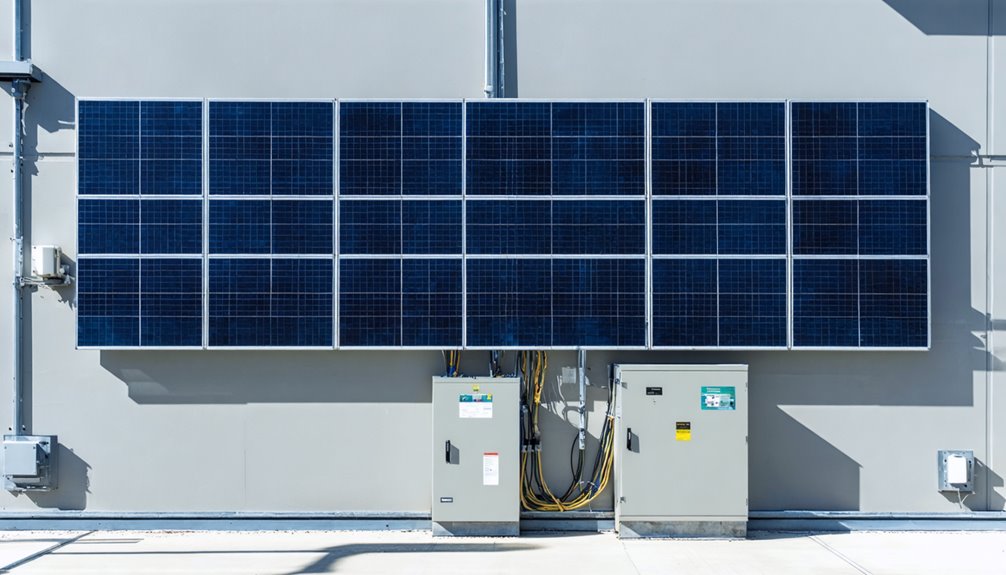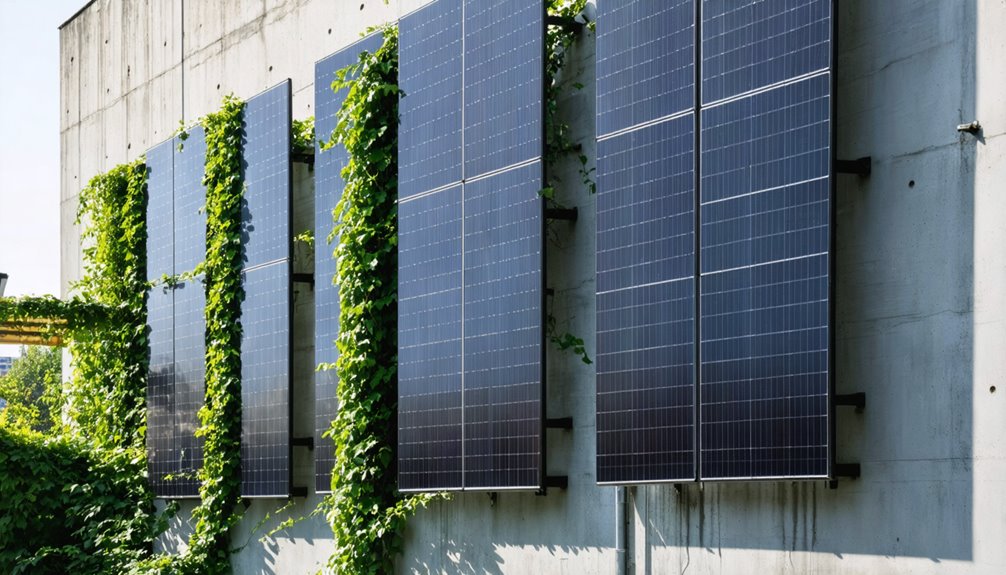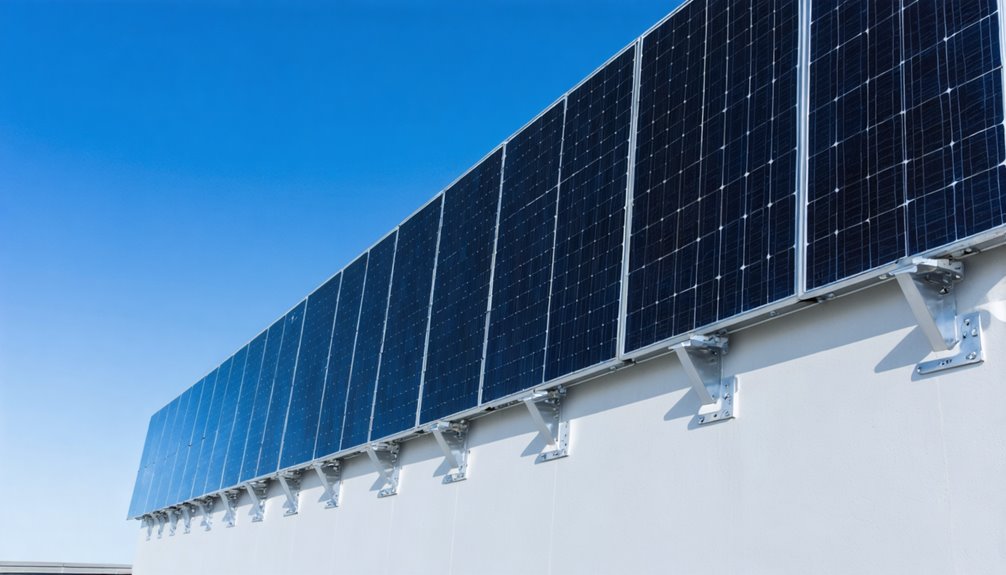Wall-mounted solar panels offer an efficient alternative to rooftop installations, generating energy on vertical surfaces while preserving roof integrity. Key benefits include optimized sunlight exposure and reduced structural stress. However, challenges like sunlight obstructions and efficient capture need consideration. Selection should assess wall orientation and load-bearing capacity, while installation focuses on structural integrity. Financial incentives help reduce costs, and environmental benefits include reduced emissions. Professional installation guarantees adherence to standards and enhances aesthetic integration for seamless architectural compatibility. Explore further to maximize your installation benefits.
Overview of Wall-Mounted Solar Panels
While traditional solar panels are commonly installed on rooftops, wall-mounted solar panels offer a practical alternative for energy generation on vertical surfaces, especially on buildings with non-standard roofing or limited horizontal space. Wall-mounted solar panels maximize energy efficiency by utilizing vertical surfaces to capture ideal sunlight in various conditions, surpassing some rooftop capabilities. These panels are designed to enhance structural integrity by distributing weight evenly across the building’s facade, minimizing roof wear and potential structural stress. Additionally, wall-mounted installations contribute to energy efficiency by mitigating heat gain on walls, assisting in maintaining interior temperatures during hot periods. Regular maintenance is essential to preserve efficiency, ensuring panels remain free from dust or shadow-casting obstructions that might impede their performance.
Benefits of Choosing Wall-Mounted Options
Choosing wall-mounted solar panels allows you to optimize sunlight exposure by leveraging vertical surfaces that can capture more energy in specific conditions, often surpassing traditional rooftop installations in efficiency. Additionally, wall mounts offer customizable design options, enhancing the aesthetic appeal of your building while maintaining peak energy production. This dual benefit not only contributes to superior energy generation but also allows for creative architectural integration, setting your property apart with both functionality and visual distinction.
Maximize Wall Sunlight Exposure
Maximizing sunlight exposure is a critical factor when considering solar panel installations, particularly for wall-mounted systems, which can capture more solar energy in specific environments. When positioned with unobstructed southern exposure, wall-mounted solar panels maximize sunlight by utilizing vertical placement, enhancing energy generation potential. This ideal orientation not only guarantees the capture of maximum solar energy but also maintains cooler wall temperatures, which enhances energy efficiency compared to rooftop alternatives. Additionally, wall-mounted systems offer increased flexibility by allowing orientation adjustments, accommodating environments where roof-mounted panels may be shaded by trees or structures. This weight distribution across building walls further enhances structural integrity and reduces roof wear, providing a longer lifespan for both the building and the installation.
Enhance Building Aesthetics
Wall-mounted solar panels offer an innovative approach to blending functionality with aesthetics, transforming ordinary vertical building surfaces into energy-producing assets while enhancing the exterior appearance. By integrating these panels, you can enhance visual appeal with modern architectural design, effectively increasing property value by an average of 6.9% according to 2025 Zillow data. Customizable designs allow for unique installations that not only beautify but also serve as eco-friendly enhancements, contributing to your building’s sustainability efforts. Additionally, distributing the weight across the walls reduces wear and tear on rooftops, promoting structural integrity and longevity. These installations also aid in lowering wall temperatures during hot weather, providing both aesthetic and functional benefits to building exteriors, which is particularly advantageous for structures with limited roof space.
Potential Challenges and Limitations
When installing wall-mounted solar panels, you face the risk of sunlight obstruction due to structures or trees, which can greatly reduce energy efficiency, while the vertical positioning of panels increases dirt accumulation, requiring more frequent cleaning than rooftop alternatives. You must also navigate structural design limitations, as not all panels are engineered for wall applications, necessitating careful selection and potential consultation with experts to optimize performance. Furthermore, consider the orientation of the wall, as it is essential for effective sunlight capture, highlighting the importance of professional advice to mitigate these challenges.
Sunlight Obstruction Risks
Facing challenges in sunlight exposure, wall-mounted solar panels often encounter obstructions from nearby structures like buildings and trees, as well as other environmental factors, which can greatly impact their efficiency. These sunlight obstruction risks can lead to reduced energy generation, as shadows from constructed elements or overhanging vegetation block necessary sunlight. While angling and orienting your panels correctly is essential to minimize shading, evaluating the surroundings before installation is just as critical. Additionally, the vertical positioning of these panels can attract dirt and dust, creating maintenance challenges that require routine attention to guarantee peak sunlight absorption. Birds and insects may also be drawn to aesthetically placed mounts, potentially interfering with functionality. Selecting panels tailored for wall mounting can help mitigate these risks.
Cleaning Frequency Concerns
As sunlight obstruction poses a notable challenge, equally pressing is the issue of cleaning frequency for wall-mounted solar panels, a concern rooted in their vertical orientation which makes them more apt to accumulate dirt and debris than their rooftop counterparts. This accumulation necessitates frequent cleaning to maintain ideal energy efficiency. Wall-mounted panels require cleaning at least every 6 to 12 months, or more often in dusty or pollen-heavy environments. Increased cleaning frequency can certainly escalate maintenance costs, potentially offsetting some energy savings derived from solar generation. Additionally, neglecting regular cleaning, including monitoring for bird and insect nests that obstruct sunlight, may greatly decrease the panel’s energy efficiency, directly impacting overall power generation effectiveness. Proactive maintenance guarantees sustained efficiency and long-term viability.
Structural Design Limitations
Although wall-mounted solar panels offer innovative energy solutions, structural design limitations present practical challenges that must be addressed to guarantee peak performance and longevity. Ensuring the structural integrity of the wall is paramount, as improperly mounted solar panels could suffer damage or failure if not designed to handle the weight and wind loads. Selecting appropriate solar mounting systems is vital to accommodate vertical positioning, as standard panels may not resist the environmental stresses unique to wall installations. Energy generation efficiency can be compromised by factors such as insufficient sunlight access due to overshadowing structures or trees, and dirt accumulation due to vertical positioning, necessitating regular maintenance. Furthermore, wall orientation plays a critical role, with south-facing walls typically achieving the highest energy yield.
Selection Criteria for Wall-Mount Panels
When you’re selecting wall-mounted solar panels, it’s crucial to take into account several factors to guarantee ideal functionality and integration with the building structure. First, assess the orientation of the wall; south-facing walls typically guarantee maximum sunlight capture, maximizing efficiency. Evaluate the size and load-bearing capacity, ensuring the wall supports the weight without risk, thereby maintaining structural integrity. Choose durable panels specifically designed for wall mounting, as they must withstand environmental challenges like wind, rain, and snow to function effectively long-term. High-efficiency ratings should be prioritized to maximize energy output from the sunlight received. Finally, consider the aesthetic compatibility with the building’s design. Customizable designs can enhance your building’s look while providing significant energy savings, making them both functional and visually appealing additions. Finally, assess how mounting orientation and system design influence the overall energy efficiency energy efficiency.
Installation Considerations for Wall Mounts

Integrating solar panels into wall-mounted installations demands a rigorous evaluation of the wall’s structural integrity to confirm it can withstand the panels’ weight and stress over time. Key installation considerations include the orientation of your wall, with south-facing walls being preferable due to their superior energy generation potential. Selecting panels explicitly designed for wall mounting ensures compatibility with specialized hardware, contributing to secure and efficient installations. Additionally, increased dirt and debris buildup on vertical surfaces requires more frequent cleaning to maintain peak performance. Consulting with an experienced installer allows you to address unique site conditions, navigate local regulations, and uphold safety standards, reinforcing your installation’s long-term success and energy-generating capacity.
Maintenance and Care Guidelines
To guarantee ideal performance and longevity of your wall-mounted solar panels, regular maintenance is vital, particularly given their vertical positioning which makes them prone to increased dust and dirt accumulation. Periodically cleaning the panels maintains optimal efficiency by preventing reduced energy generation caused by dirt buildup. Inspect your solar installation for obstructions that could cast shadows, and regularly check for nests or hives of birds and insects that could impair functionality. In addition, maintaining wires and connections is essential to avoid electrical issues, which can affect system durability and performance. Making sure panel selection prioritizes durability to withstand environmental elements greatly contributes to the panels’ lifespan. Moreover, strategically orienting wall mounts to capture the maximum sunlight enhances the overall energy output of the system. When selecting components, ensure the mounting system meets wind load ratings and snow load requirements to withstand local conditions.
Cost Factors and Financial Incentives
While maintaining your wall-mounted solar panels guarantees their performance and longevity, considering the financial aspects of installation is equally important. The initial cost factors of wall-mounted solar panels vary greatly based on the size and type, with professional installation costs potentially increasing expenses. However, financial incentives offer substantial relief. Local tax incentives can greatly reduce overall installation costs through credits or deductions, providing an enticing financial landscape. Additionally, the federal solar tax credit allows you to claim 30% of installation costs, including the wall mounts, considerably reducing the financial burden. Beyond energy savings, investing in solar panels can also enhance property value, offering a potential return on investment. Therefore, thoroughly evaluating these financial factors is essential before proceeding with your solar panel installation.
Environmental Impact and Sustainability

In considering the environmental impact and sustainability of wall-mounted solar panels, you’ll appreciate their dual benefits of reducing greenhouse gas emissions and enhancing resource efficiency, as they generate clean energy using vertical surfaces that conserve land. These installations leverage eco-friendly materials, further minimizing environmental disruption and aligning with the need for durable yet sustainable solutions. By embracing this technology, not only do you support energy independence through renewable sources, but you also contribute to the reduction of carbon footprints, collectively benefiting urban ecosystems and promoting sustainability in modern architecture.
Emission Reduction Benefits
By embracing wall-mounted solar panels, you contribute to emission reduction efforts through the generation of clean electricity, substantially decreasing reliance on fossil fuels and lowering greenhouse gas emissions. Shifting to solar energy enables you to offset around 3,500 pounds of carbon dioxide annually per typical residential system, according to the U.S. Environmental Protection Agency. The widespread adoption of solar energy could lead to a remarkable national reduction of over 80 million metric tons of CO2 emissions, enhancing sustainable energy solutions. Additionally, harnessing solar energy facilitates a reduction in air pollutants from conventional sources, positively impacting public health and environmental quality. Aligning with these eco-friendly practices not only diminishes your carbon footprint but potentially raises property value, reinforcing commitment to sustainable practices.
Resource Efficiency Practices
Converting vertical spaces into energy-generating surfaces with wall-mounted solar panels maximizes resource efficiency, especially essential in urban environments where roof space is limited. This approach not only utilizes otherwise neglected spaces but also considerably reduces reliance on non-renewable energy sources, thereby promoting sustainable energy practices. The integration of high-efficiency solar panels guarantees that even compact installations generate substantial power, enhancing the sustainability of energy systems in densely built environments.
Eco-Friendly Materials Usage
Eco-friendly materials are transforming the production of wall mounts for solar panels, considerably enhancing their environmental sustainability. By utilizing recycled aluminum and stainless steel, manufacturers markedly lessen environmental impact, as these resources reduce the need for new raw material extraction and energy consumption. The application of eco-friendly coatings extends mount lifespan, diminishing the detrimental emissions typical of conventional finishing methods and consequently contributing to a reduced carbon footprint. Additionally, the modular design of eco-friendly solar mounts minimizes waste, facilitating easy upgrades or replacements without necessitating complete system disposal. Many companies commit to sustainability certifications like LEED or Energy Star, ensuring adherence to rigorous environmental standards. These initiatives collectively enhance energy efficiency in structures, supporting sustainable building practices and decreasing reliance on fossil fuels.
Aesthetic Integration and Design Options
How do wall-mounted solar panels transform the mundane into the extraordinary while providing exceptional energy solutions? By offering aesthetic value, customizable designs, and contributing to innovative urban designs, wall-mounted solar panels complement architectural styles and enhance visual appeal. Customizable designs, with various colors and finishes, allow these installations to integrate seamlessly with residential and commercial structures. Unlike traditional rooftop installations, wall-mounted panels can sometimes capture sunlight more effectively, boosting their aesthetic appeal. By incorporating these panels, buildings can transform vertical surfaces into functional works of art, reflecting a commitment to sustainability. In addition, these installations present an opportunity to create unique, modern façades that promote green energy solutions in a visually impactful manner, rendering them icons of both technological advancement and aesthetic innovation.
Working With Professional Installers
Although installing wall-mounted solar panels yourself might seem like a viable option, hiring professional installers guarantees that every aspect of your solar installation meets high industry standards and building-specific requirements. Professional installers assess compatibility with your building’s structure, ensuring that panels are installed without sealant, thereby preserving structural integrity. They select wall mounts and panels tailored for vertical setups, securing ideal angle and orientation for maximum sunlight exposure. Certified professionals navigate local codes, preventing fines or complications related to non-compliant installations. Additionally, they provide tailored solutions, blending solar panels with existing aesthetics seamlessly. Installation often includes warranties, offering peace of mind for maintenance needs.
| Expertise Benefit | Technical Assurance | Aesthetic Advantage |
|---|---|---|
| Assess compatibility | Meet local regulations | Enhance building design |
| Secure ideal orientation | Warranty coverage | Integrated appearance |
| Certified professionalism | Installed without sealant | Tailored solutions |
Conclusion
Choosing wall-mounted solar panels requires careful evaluation of installation requirements, cost factors, aesthetic considerations, environmental benefits, and available financial incentives. By establishing clear selection criteria and collaborating with experienced installers, property owners can maximize energy efficiency and achieve long-term sustainability goals for residential or commercial applications. While implementation challenges may arise, proper assessment and planning enable wall-mounted solar panels to serve as an effective solution for renewable energy generation and carbon footprint reduction. Solocity Global stands as a trusted exporter of solar panel mounting systems, providing high-quality, standards-compliant mounting solutions to clients across global markets.


